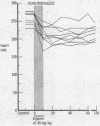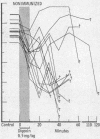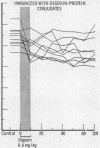Abstract
The lethal dose of digoxin was determined by administering 10 ml of a digoxin-saline solution to 26 nonimmunized rabbits through an ear vein over a 10 min period. Rabbits receiving less than 0.45 mg/kg digoxin showed no toxic effect, whereas all 15 rabbits that received 0.5 mg/kg developed an early arrhythmia and died within 1 hr. Moreover, eight rabbits which had been immunized with antigens unrelated to digoxin or injected with Freund's adjuvant mixture all died after receiving 0.6 mg/kg digoxin. Thus, it was concluded that 0.6 mg/kg digoxin was uniformly lethal in rabbits that had not been immunized or had received antigens unrelated to digoxin.
By way of contrast, 17 rabbits immunized with a digoxin-albumin conjugate in complete Freund's adjuvant formed digoxin-specific antibodies and survived doses of digoxin varying between 0.6 and 0.9 mg/kg. In 10 rabbits immunized with digoxin-albumin conjugates, digoxin-specific antibody titers were determined following the administration of digoxin. There was a significant fall in antibody titer.
This study indicates that rabbits protected by digoxin-specific antibodies suffer no acute adverse effects from an amount of digoxin which is uniformly lethal in nonimmunized rabbits and in rabbits immunized with other antigens.
Full text
PDF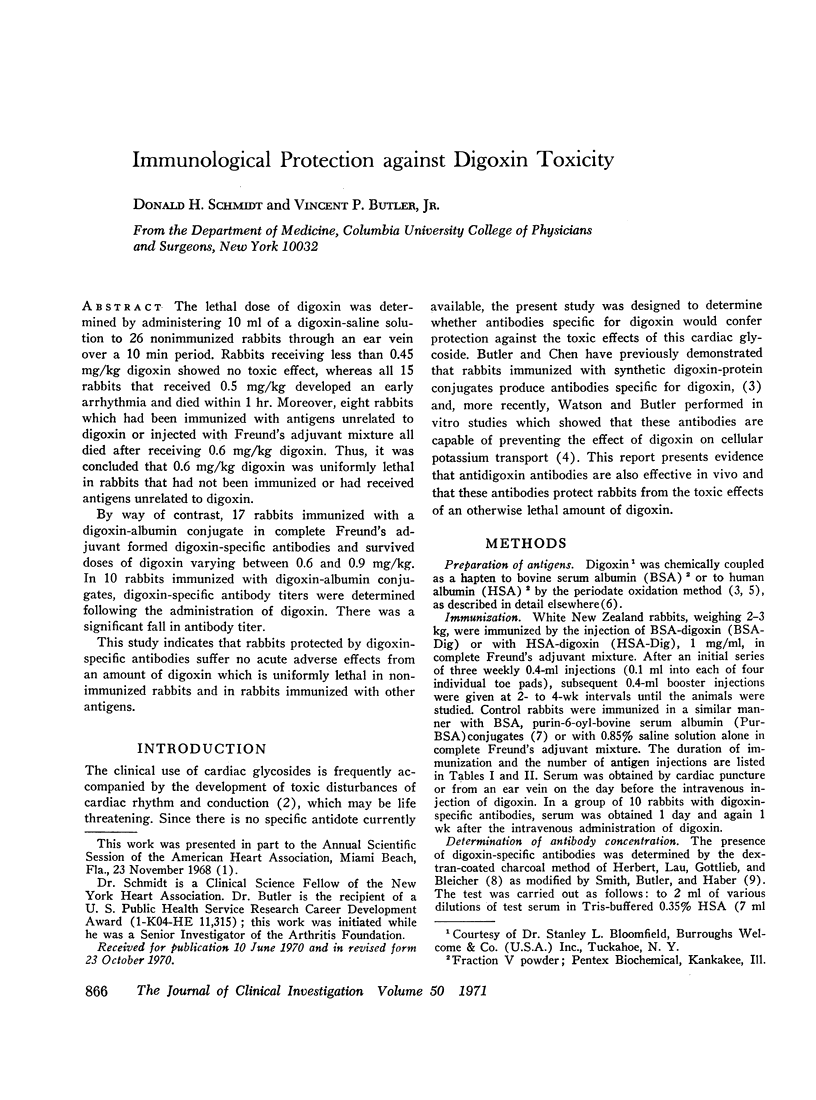
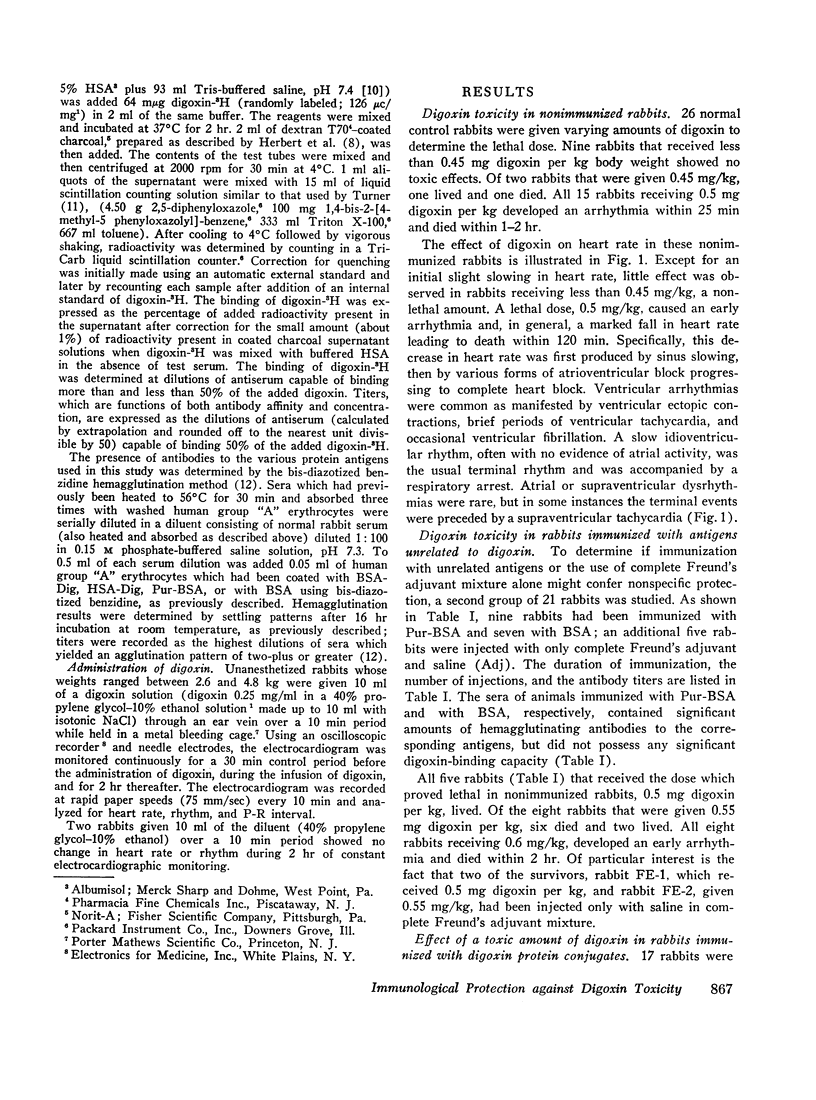
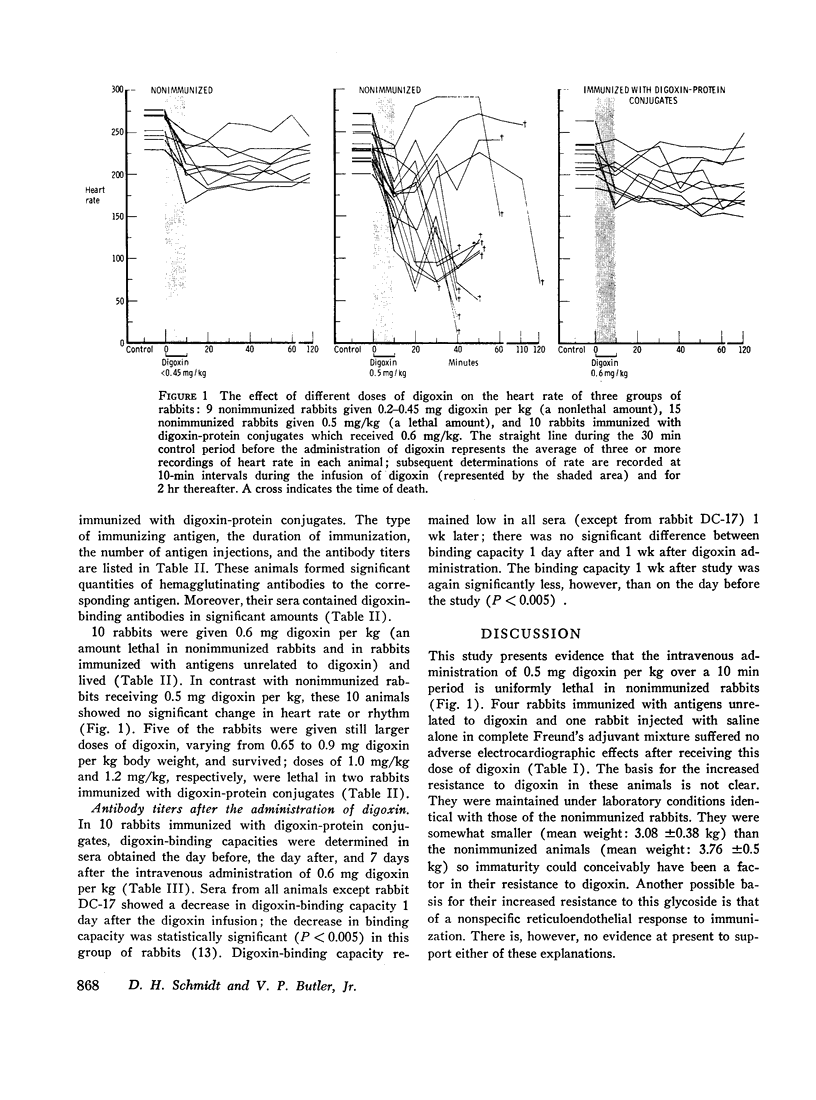
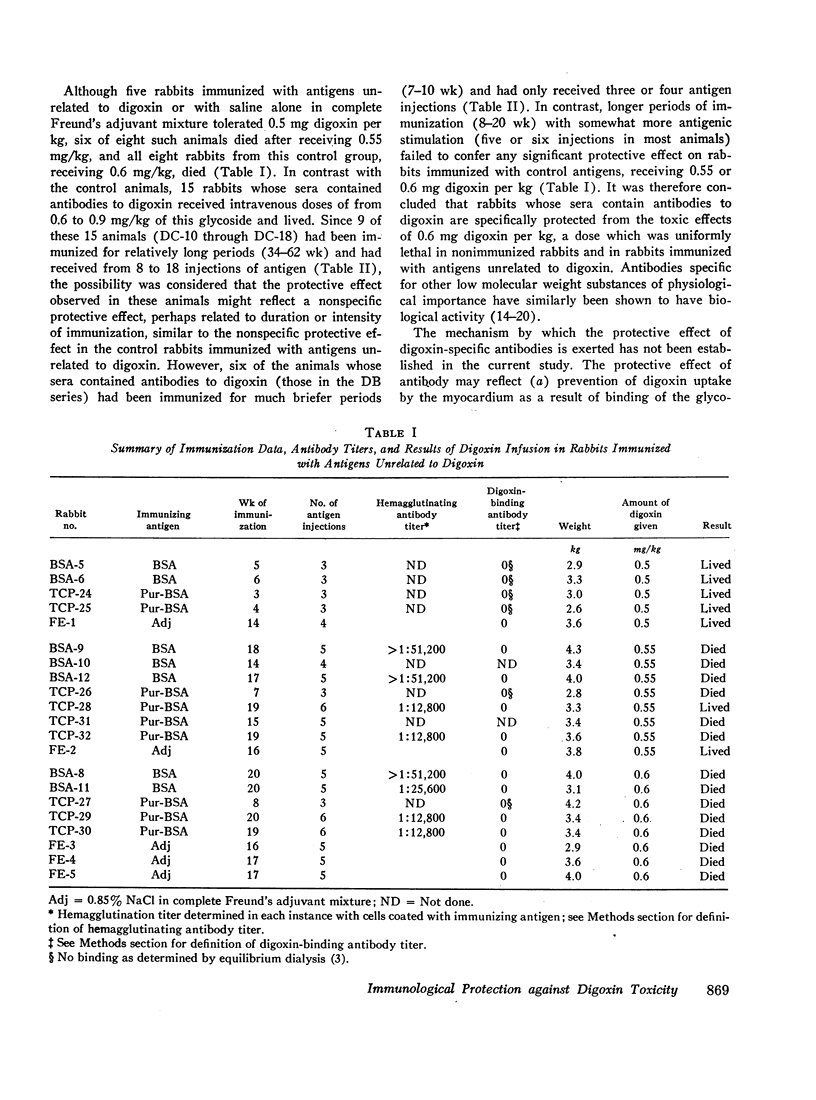
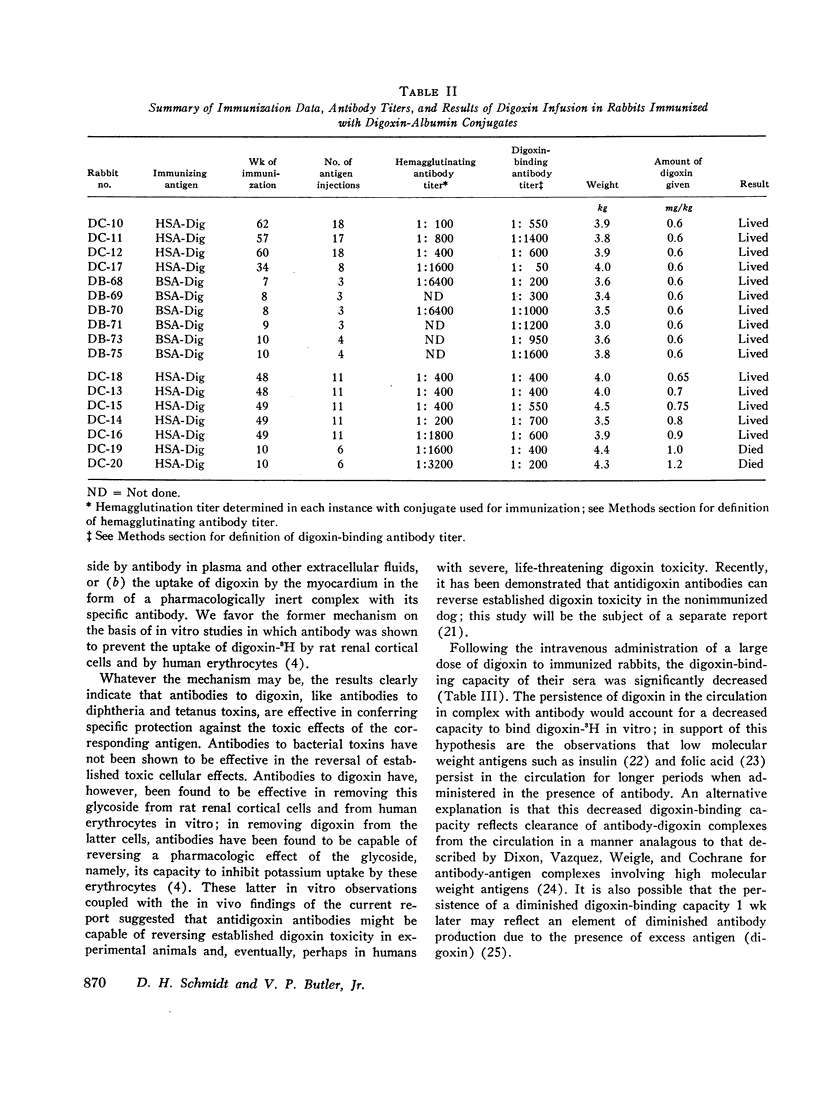
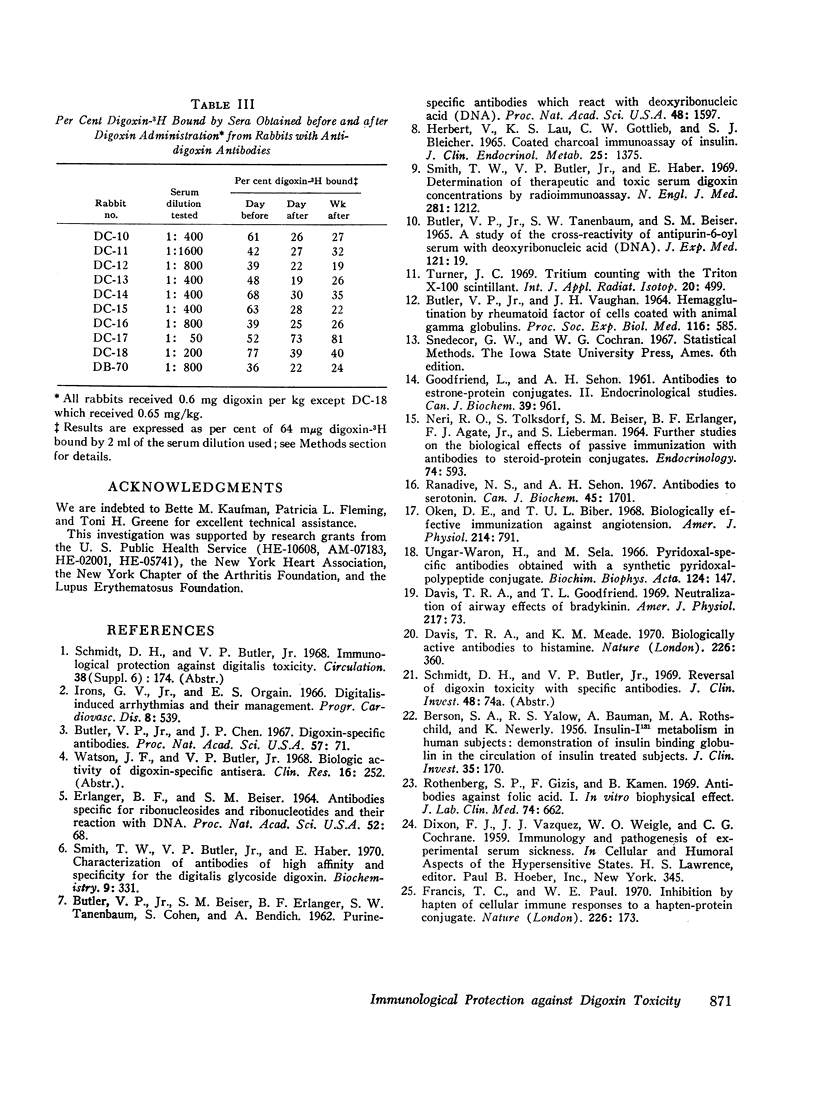
Images in this article
Selected References
These references are in PubMed. This may not be the complete list of references from this article.
- BERSON S. A., YALOW R. S., BAUMAN A., ROTHSCHILD M. A., NEWERLY K. Insulin-I131 metabolism in human subjects: demonstration of insulin binding globulin in the circulation of insulin treated subjects. J Clin Invest. 1956 Feb;35(2):170–190. doi: 10.1172/JCI103262. [DOI] [PMC free article] [PubMed] [Google Scholar]
- BUTLER V. P., Jr, BEISER S. M., ERLANGER B. F., TANENBAUM S. W., COHEN S., BENDICH A. Purine-specific antibodies which react with deoxvribonucleic acid (DNA). Proc Natl Acad Sci U S A. 1962 Sep 15;48:1597–1602. doi: 10.1073/pnas.48.9.1597. [DOI] [PMC free article] [PubMed] [Google Scholar]
- BUTLER V. P., Jr, TANENBAUM S. W., BEISER S. M. A STUDY OF THE CROSS-REACTIVITY OF ANTIPURIN-6-OYL SERUM WITH DEOXYRIBONUCLEIC ACID (DNA). J Exp Med. 1965 Jan 1;121:19–38. doi: 10.1084/jem.121.1.19. [DOI] [PMC free article] [PubMed] [Google Scholar]
- BUTLER V. P., Jr, VAUGHAN J. H. HEMAGGLUTINATION BY RHEUMATOID FACTOR OF CELLS COATED WITH ANIMAL GAMMA GLOBULINS. Proc Soc Exp Biol Med. 1964 Jul;116:585–593. doi: 10.3181/00379727-116-29313. [DOI] [PubMed] [Google Scholar]
- Butler V. P., Jr, Chen J. P. Digoxin-specific antibodies. Proc Natl Acad Sci U S A. 1967 Jan;57(1):71–78. doi: 10.1073/pnas.57.1.71. [DOI] [PMC free article] [PubMed] [Google Scholar]
- Davis T. R., Goodfriend T. L. Neutralization of airway effects on bradykinin by antibodies. Am J Physiol. 1969 Jul;217(1):73–77. doi: 10.1152/ajplegacy.1969.217.1.73. [DOI] [PubMed] [Google Scholar]
- Davis T. R., Meade K. M. Biologically active antibodies to histamine. Nature. 1970 Apr 25;226(5243):360–360. doi: 10.1038/226360a0. [DOI] [PubMed] [Google Scholar]
- ERLANGER B. F., BEISER S. M. ANTIBODIES SPECIFIC FOR RIBONUCLEOSIDES AND RIBONUCLEOTIDES AND THEIR REACTION WITH DNA. Proc Natl Acad Sci U S A. 1964 Jul;52:68–74. doi: 10.1073/pnas.52.1.68. [DOI] [PMC free article] [PubMed] [Google Scholar]
- Francis T. C., Paul W. E. Inhibition by hapten of cellular immune responses to a hapten-protein conjugate. Nature. 1970 Apr 11;226(5241):173–174. doi: 10.1038/226173a0. [DOI] [PubMed] [Google Scholar]
- GOODFRIEND L., SEHON A. H. Antibodies to estrone-protein conjugates. II. Endocrinological studies. Can J Biochem Physiol. 1961 May;39:961–965. doi: 10.1139/o61-094. [DOI] [PubMed] [Google Scholar]
- Herbert V., Lau K. S., Gottlieb C. W., Bleicher S. J. Coated charcoal immunoassay of insulin. J Clin Endocrinol Metab. 1965 Oct;25(10):1375–1384. doi: 10.1210/jcem-25-10-1375. [DOI] [PubMed] [Google Scholar]
- Irons G. V., Jr, Orgain E. S. Digitalis-induced arrhythmias and their management. Prog Cardiovasc Dis. 1966 May;8(6):539–569. doi: 10.1016/s0033-0620(66)80015-4. [DOI] [PubMed] [Google Scholar]
- NERI R. O., TOLKSDORF S., BEISER S. M., ERLANGER B. F., AGATE F. J., Jr, LIEBERMAN S. FURTHER STUDIES ON THE BIOLOGICAL EFFECTS OF PASSIVE IMMUNIZATION WITH ANTIBODIES TO STEROID-PROTEIN CONJUGATES. Endocrinology. 1964 Apr;74:593–598. doi: 10.1210/endo-74-4-593. [DOI] [PubMed] [Google Scholar]
- Oken D. E., Biber T. U. Biologically effective immunization against angiotensin. Am J Physiol. 1968 Apr;214(4):791–795. doi: 10.1152/ajplegacy.1968.214.4.791. [DOI] [PubMed] [Google Scholar]
- Ranadive N. S., Sehon A. H. Antibodies to serotonin. Can J Biochem. 1967 Nov;45(11):1701–1710. doi: 10.1139/o67-201. [DOI] [PubMed] [Google Scholar]
- Rothenberg S. P., Gizis F., Kamen B. Antibodies against folic acid. I. In vitro biophysical effect. J Lab Clin Med. 1969 Oct;74(4):662–671. [PubMed] [Google Scholar]
- Smith T. W., Butler V. P., Jr, Haber E. Characterization of antibodies of high affinity and specificity for the digitalis glycoside digoxin. Biochemistry. 1970 Jan 20;9(2):331–337. doi: 10.1021/bi00804a020. [DOI] [PubMed] [Google Scholar]
- Smith T. W., Butler V. P., Jr, Haber E. Determination of therapeutic and toxic serum digoxin concentrations by radioimmunoassay. N Engl J Med. 1969 Nov 27;281(22):1212–1216. doi: 10.1056/NEJM196911272812203. [DOI] [PubMed] [Google Scholar]
- Ungar-Waron H., Sela M. Pyridoxal-specific antibodies obtained with a synthetic pyridoxal-polypeptide conjugate. Biochim Biophys Acta. 1966 Jul 27;124(1):147–153. doi: 10.1016/0304-4165(66)90322-9. [DOI] [PubMed] [Google Scholar]



